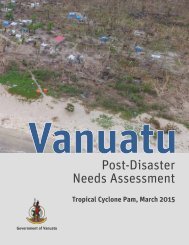Fiji
yqgk302EGjo
yqgk302EGjo
You also want an ePaper? Increase the reach of your titles
YUMPU automatically turns print PDFs into web optimized ePapers that Google loves.
FIJI Post-Disaster Needs Assessment<br />
Recovery and Reconstruction Needs for the Water and Sanitation Sector (F$24 million)<br />
Total recovery costs are estimated at F$3.6 million, and total reconstruction costs in 2016 and 2017 are estimated at<br />
F$20.7 million with details shown in Table 58. Specific needs raised by city councils include paving access roads to landfill<br />
sites and construction of transfer stations.<br />
The recovery strategy needs to be aligned with existing development frameworks, such as the <strong>Fiji</strong> Green Growth Framework.<br />
It also must adhere to the principles of BBB and advocate and strengthen resilience in water and sanitation systems to<br />
ensure communities have access to reliable and safe water supply and sanitation services at all times. Strengthening the<br />
engagement of rural village committees and leaders in WASH systems is also an area requiring further support through<br />
relevant government authorities and partners. The amount and restrictions around the municipal contingency funding<br />
scheme should be reviewed on a medium-term basis.<br />
Table 58: Total Recovery and Reconstruction Needs for the Water and Sanitation Sector (F$ million)<br />
Recovery Reconstruction Resilience Total<br />
Repair and reconstruction of WAF assets 16.43 16.43<br />
Repair or buy new water storage tanks, fees for carting,<br />
water monitoring and testing, rural water schemes<br />
Urban waste disposal costs, upgrade waste water<br />
treatment plants (add mechanical screens)<br />
1.11 3.50 4.61<br />
2.20 0.11 2.31<br />
Purchase generator sets 0.25 0.25<br />
Strengthen institutional capacity in sector, including<br />
provision of experienced advisor with technical expertise<br />
of water treatment in the strategic planning department<br />
in WAF, review of tariff, preparation of water and waste<br />
management plans<br />
0.04 0.01 0.05<br />
Pave access road to landfills 0.23 0.23<br />
Build transfer stations for solid waste 0.40 0.40<br />
Total 3.6 20.7 24.3<br />
Source: Estimations by Assessment Team.<br />
Note: A detailed breakdown of recovery needs by sector is included in Annex 2.<br />
3.3.3 Electricity<br />
Summary<br />
Following TC Winston, the power supply was disrupted to all FEA customers. Full reconnection is anticipated by June<br />
or July 2016. An estimated 1,500 residential customers whose homes were destroyed are expected to be reconnected<br />
progressively over the next 12 months as reconstruction proceeds. TC Winston caused significant damage to the<br />
distribution grid and somewhat lower levels of damage to power generation and transmission infrastructures.<br />
Damage to the Department of Energy’s (DoE) rural power generation assets was significant, with approximately 54 diesel<br />
mini-grids and 609 solar home systems affected.<br />
Total damage and loss in the electricity sector is estimated at F$41.1 million, consisting of F$33 million for the replacement<br />
of damaged power sector infrastructure and F$8.1 million in losses to FEA, mainly from loss of revenue.<br />
Electricity Sector Background<br />
FEA is a government-owned statutory agency that is responsible for the generation, transmission, distribution and retail<br />
sale of electricity in <strong>Fiji</strong>. It operates four separate power grids on Viti Levu, Vanua Levu (Labasa and Savusavu) and Ovalau,<br />
and produces electricity from a mix of diesel, hydropower and wind. During the 12-month period from January 2015<br />
to December 2015, FEA generated 892,045MWh (megawatt hours) of energy with system losses (both technical and<br />
nontechnical) 105 of 9.65 percent. Over the same period, FEA had total electricity sales revenue of F$312 million. A summary<br />
of baseline power assets is presented in Table 59.<br />
105<br />
Technical losses are physical losses (e.g., thermal losses), while nontechnical losses are those that FEA incurs through meter fraud,<br />
illicit connections, etc.<br />
86 Tropical Cyclone Winston, February 20, 2016



